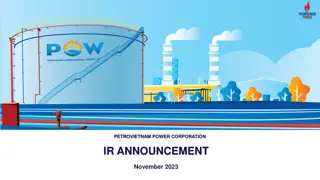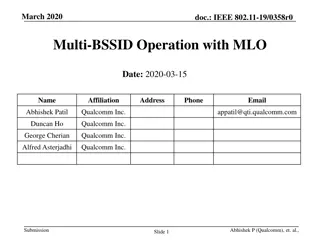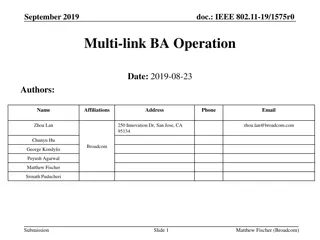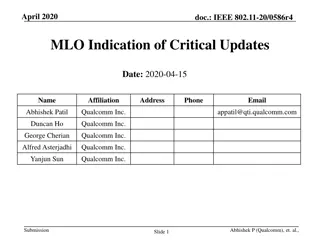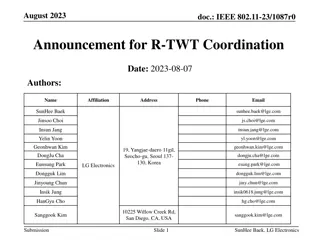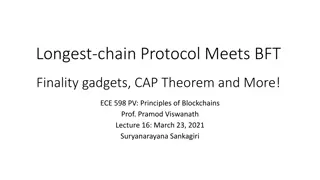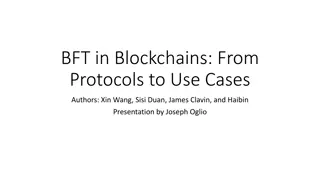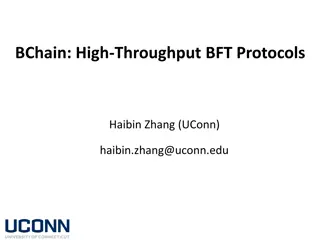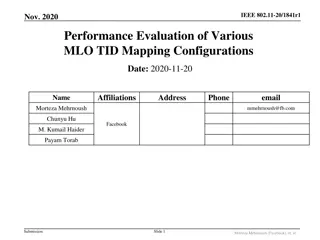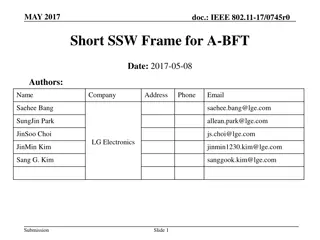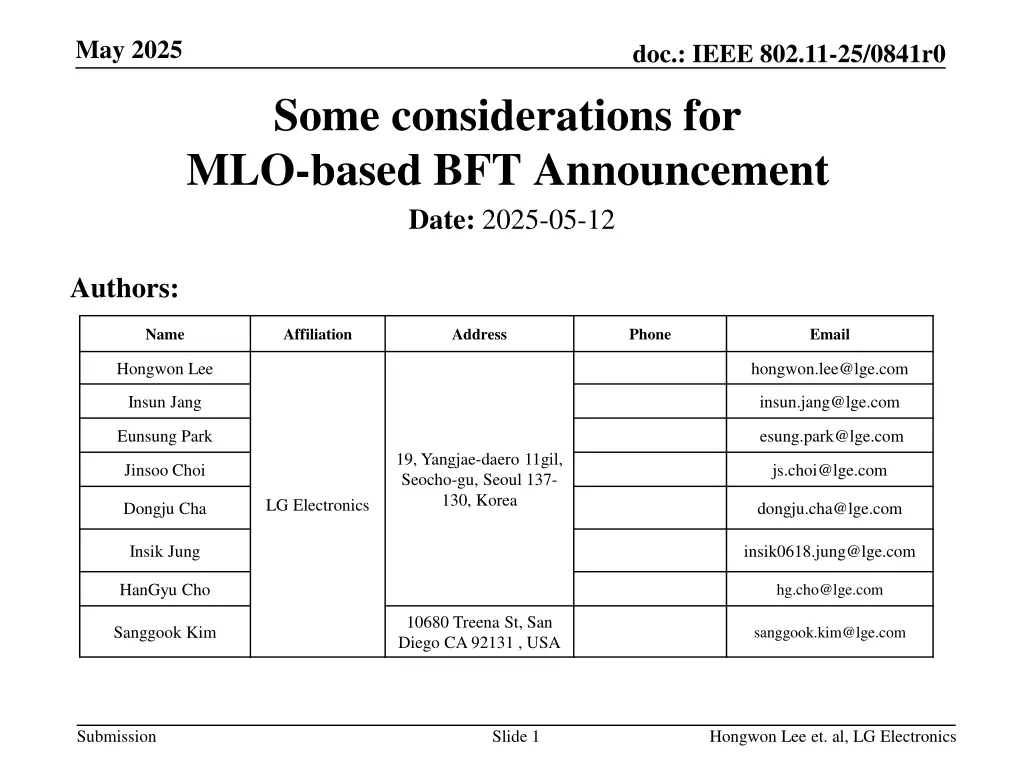
MLO-Based Beamforming Training Considerations for IEEE 802.11-25
Explore key insights for designing the MLO-based Beamforming Training (BFT) in IEEE 802.11-25, focusing on BFT examples and scheduling for individual and multiple STAs. The document discusses dynamic BFT, static BFT, and how BFT information can be included in signaling frames over sub-7GHz links, providing valuable insights for BFT design.
Download Presentation

Please find below an Image/Link to download the presentation.
The content on the website is provided AS IS for your information and personal use only. It may not be sold, licensed, or shared on other websites without obtaining consent from the author. If you encounter any issues during the download, it is possible that the publisher has removed the file from their server.
You are allowed to download the files provided on this website for personal or commercial use, subject to the condition that they are used lawfully. All files are the property of their respective owners.
The content on the website is provided AS IS for your information and personal use only. It may not be sold, licensed, or shared on other websites without obtaining consent from the author.
E N D
Presentation Transcript
May 2025 doc.: IEEE 802.11-25/0841r0 Some considerations for MLO-based BFT Announcement Date: 2025-05-12 Authors: Name Affiliation Address Phone Email Hongwon Lee hongwon.lee@lge.com Insun Jang insun.jang@lge.com Eunsung Park esung.park@lge.com 19, Yangjae-daero 11gil, Seocho-gu, Seoul 137- 130, Korea Jinsoo Choi js.choi@lge.com LG Electronics Dongju Cha dongju.cha@lge.com Insik Jung insik0618.jung@lge.com HanGyu Cho hg.cho@lge.com 10680 Treena St, San Diego CA 92131 , USA Sanggook Kim sanggook.kim@lge.com Submission Slide 1 Hongwon Lee et. al, LG Electronics
May 2025 doc.: IEEE 802.11-25/0841r0 Introduction Generally, 11bq focuses on an MLD with which at least one STA operating on a mmWave bands is affiliated [5] We discussed how Beamforming Training (BFT) can be performed using sub-7GHz signaling [5] In this contribution, we would like to examine a few BFT examples to derive key insights for designing the BFT information announcement frame With this, we share our thoughts on how to design the MLO-based Beamforming Training (BFT) Announcement frame For convenience, we call STAs (or APs) operating on mmWave bands mSTA (or mAPs) and also call STAs (or APs) operating on sub-7GHz bands sSTA (or sAPs) Submission Slide 2 Hongwon Lee et. al, LG Electronics
May 2025 doc.: IEEE 802.11-25/0841r0 Recap: MLO-based Beamforming Training [5] Dynamic BFT Dynamic BFT schedule(s) based on Request/Response frame exchanges or an announced frame (Semi-) Static BFT It would be similar to broadcast I-TXSS, which may be ON and OFF Submission Slide 3 Hongwon Lee et. al, LG Electronics
May 2025 doc.: IEEE 802.11-25/0841r0 BFT example scheduling for Individual STA This is a simple example for signaling BFT information to a non-AP MLD BFT information can be included in a signaling frame (e.g., Request/Response and/or Announcement) over a sub-7GHz link For convenience, this kind of information can be treated as per-user information (Per-User Info) for BFT in this contribution Submission Slide 4 Hongwon Lee et. al, LG Electronics
May 2025 doc.: IEEE 802.11-25/0841r0 BFT example scheduling for multiple STAs We can consider one-shot scheduling for multiple non-AP MLDs performing BFT on the same link In this case, both Common Info and Per-User Info for BFT can be included in the BFT Request (or BFT Announcement) Submission Slide 5 Hongwon Lee et. al, LG Electronics
May 2025 doc.: IEEE 802.11-25/0841r0 BFT example Broadcast I-TXSS Broadcast I-TXSS can be performed for non-specified multiple non-AP MLDs One or more non-AP MLDs can request R-TXSS using this Broadcast I-TXSS, as needed or on demand Broadcast I-TXSS may be performed periodically Submission Slide 6 Hongwon Lee et. al, LG Electronics
May 2025 doc.: IEEE 802.11-25/0841r0 BFT example on demand In some cases, BFT is required during the frame exchange due to environment changes such as mobility, channel status, and so on In this case, full or partial BFT is required Submission Slide 7 Hongwon Lee et. al, LG Electronics
May 2025 doc.: IEEE 802.11-25/0841r0 Considerations for designing BFT Announcement in sub-7GHz Unified frame design for BFT Announcement Different types of BFT procedures (e.g., SLS Only, ISS Only, RSS Only, Broadcast I-TXSS, BRP Only, Full(one-shot) BFT(SLS + BRP) and so on) can be indicated using the unified BFT announcement frame In the initial phase, one-shot BFT for one or more users may be performed to find beam pattern each other If a user has BFT information obtained in the previous BFT phase, partial BFT(e.g. R- TXSS Only, BRP Only, etc.) may be possible BFT may be required after initialization in certain cases, such as following environmental changes, and it should be decided which BFT procedures are performed Scalability to support multiple users Common Information for multiple users (e.g., Common BFT information for the same BFT schedule and/or a common BFT schedule for broadcast I-TXSS) User-Specific Information for each user (e.g., specific BFT sub-schedules for each user, such as RSS) Periodicity for (semi-) static BFT In certain cases, periodic BFT(e.g. Broadcast I-TXSS) may be performed for non- specified multiple users Slide 8 Submission Hongwon Lee et. al, LG Electronics
May 2025 doc.: IEEE 802.11-25/0841r0 Conclusion This contribution provides several examples for MLO-based Beamforming Training (BFT) Through these examples, we could derive some discussion points outlined below We discussed several aspects to designing BFT Announcement(or Request/Response) procedure Unified frame design for BFT Announcement Scalability to support multiple users Periodicity Submission Slide 9 Hongwon Lee et. al, LG Electronics
May 2025 doc.: IEEE 802.11-25/0841r0 Straw Poll 1 Do you support the following text in 11bq? 11bq defines new frames or reuses/enhances existing frames, where a STA affiliated with an MLD and operating in a Sub-7GHz band indicates beamforming training(BFT) information for a mmWave band Details are TBD Submission Slide 10 Hongwon Lee et. al, LG Electronics
May 2025 doc.: IEEE 802.11-25/0841r0 Straw Poll 2 Do you support the following text in 11bq? 11bq allows the inclusion of the BFT Type information in the frame that carries beamforming training (BFT) information, indicating what kind of BFT procedures are being used (e.g., SLS only, BRP only, etc.) Which BFT procedures are TBD Submission Slide 11 Hongwon Lee et. al, LG Electronics
May 2025 doc.: IEEE 802.11-25/0841r0 Straw Poll 3 Do you support the following text in TGbq? 11bq defines new frames or reuses/enhances existing frames, where a STA affiliated with an MLD and operating in a Sub-7GHz band indicates common and user specific beamforming training information to its associated STA(s) affiliated with MLD(s) for beamforming training on a link in a mmWave band Common beamforming training information is same information for all associated STA(s) affiliated with MLD(s) User specific beamforming training information is information for each associated STA(s) affiliated with MLD(s) Submission Slide 12 Hongwon Lee et. al, LG Electronics
May 2025 doc.: IEEE 802.11-25/0841r0 Straw Poll 4 Do you support the following text in TGbq? 11bq defines a mechanism where a STA, that is affiliated with an MLD and operating in a Sub-7GHz band, announces a periodic duration to its associated STA(s) affiliated with other MLD(s) for beamforming training on a link in a mmWave band Submission Slide 13 Hongwon Lee et. al, LG Electronics
May 2025 doc.: IEEE 802.11-25/0841r0 References [1] IEEE P802.11-REVme [2] 24/1312, Draft P802.11bq PAR [3] 11-23/1905, High Level Thoughts on IMMW [4] 11-23/1968, Discussion on general direction of integrated mmWave [5] 11-25/431, MLO-based Scheduling for IMMW /D7.0 Submission Slide 14 Hongwon Lee et. al, LG Electronics


